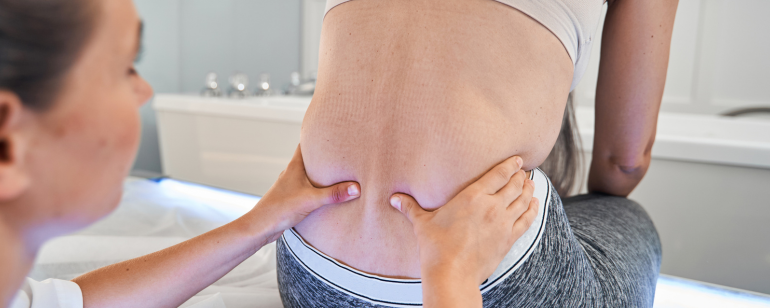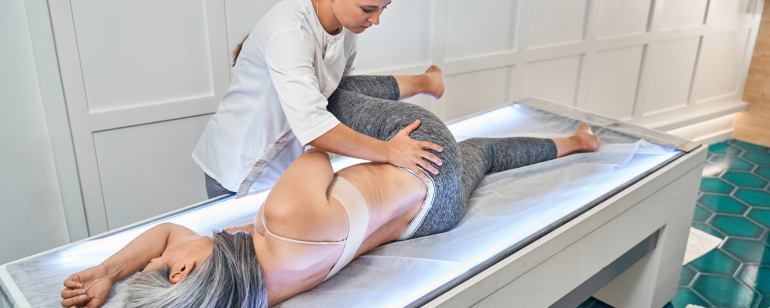One-sided pain in the lower back that occurs when sitting, standing up or turning is often caused by the sacroiliac joint (SIJ). At our practice in Berlin-Mitte, we regularly treat patients with precisely these complaints.
What is the sacroiliac joint?
The SIJ connects the sacrum to the ilium. It is tightly guided and allows minimal movement. However, these small movements are crucial for the balance between the pelvis, spine and legs.

Causes of complaints in the SI joint
The sacroiliac joint can be irritated or blocked by various factors. Frequent triggers:
- Long, one-sided sitting, e.g. in the office or car
- Leg length difference, congenital or acquired
- Pelvic changes after birth
- Fall on the buttocks or pelvis
- Incorrect loads due to sport or everyday life
Many patients report that the pain does not occur directly in the middle of the back, but slightly to the side – often at the level of the buttocks. The pain sometimes radiates into the groin or thigh.
How can you recognize an SI joint problem?
Typical indications:
- Pain when sitting, especially on soft surfaces
- Restrictions when bending or turning
- Difficulty getting up from a sitting position
- Feeling of instability in the pelvis
These symptoms are not always clear. A precise examination is therefore important.
How we proceed in physiotherapy
At Physiotherapie Berlin Mitte Marsch, we first carry out a detailed assessment. In doing so, we check
- Mobility in the ISG
- Position of the pelvis and lumbar spine
- Muscle tension in the buttocks, back and thighs
- Stress patterns in everyday life
Depending on the findings, we use targeted mobilization techniques. The aim is to restore movement in the joint, regulate muscular tension and harmonize the interaction of the pelvis and spine.
Treatment approaches
Our therapeutic measures include
- Manual mobilization of the SI joint
- Strengthening the stabilizing muscles, especially the buttocks and torso
- Stretching shortened structures, e.g. hip flexors
- Fascia treatment to release tension
- Posture and movement training for everyday life and work
We provide specific exercises that are tailored to your situation. In this way, we promote self-awareness and reduce the risk of new blockages.
What you can do yourself
- Make sure you exercise regularly in everyday life
- Avoid sitting rigidly for long periods of time
- Use a firm surface, not soft cushions
- Move consciously and slowly in the morning after getting up
- Strengthen the muscles around your pelvis and back
These measures support the therapy and improve stability in the lower back in the long term.

Conclusion: keep an eye on the SI joint
Pain in the sacroiliac joint is common, but often difficult to pinpoint. At Physiotherapie Berlin-Mitte Marsch, we analyze the causes precisely and provide targeted treatment – with the aim of restoring your mobility and quality of life in everyday life.
3 simple exercises to relieve the sacroiliac joint
These exercises support mobility in the SI joint, release muscular tension and promote stability in the lower back. Perform the exercises slowly and in a controlled manner. If you experience pain: stop and seek medical advice.
1. leg swing in supine position
Aim: mobilization of the pelvis, gentle movement in the SI joint
- Lie on your back, legs up, arms at your sides
- Let both knees slowly tilt to the right, then back to the center
- Then tilt to the left
- Movement remains small and pain-free
- Repetition: 10-15 times per side
2. cat hump – horse back in quadruped position
Aim: to release tension in the pelvic and lumbar region
- Stand on four feet with your hands under your shoulders and your knees under your hips
- As you exhale: round your back, chin towards your chest
- When inhaling: lower your stomach, raise your head slightly
- Repetition: 10-12 times at a calm pace
3. pelvic tilt while sitting or standing
Aim: training pelvic mobility
- Sit on a stool or stand upright
- Tilt your pelvis slightly forward (hollow back), then back (rounded back)
- Only move your pelvis, keep your upper body still
- Repetition: 10-15 times slowly alternating
